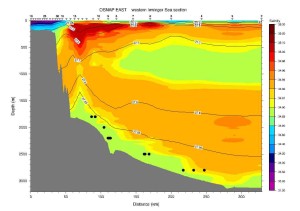
As we head back towards Reykjavik, 19 long cylindrical glass floats are just beginning their own journeys.
Over the course of our month at sea, WHOI technician Elizabeth Bonk deployed floats into the ocean. Weights on the bottom carried them thousands of meters down, almost to the bottom. These floats will follow the Deep Western boundary current, mapping the pathways of the dense water as it peels away from Greenland. There is no telling where they will go.
Sound sources on moorings will send out signals to the floats. The floats will listen, and record: The time of arrival of a sound signal indicates how far away the floats are from the sound sources.
When the floats were originally developed, they were called SOFAR floats, named for the SOund Fixing And Ranging channel. This channel is a horizontal slice of the ocean where the sound travels at its slowest, bouncing back and forth like light in a fibre optic cable, and traveling long distances instead of just dispersing all over the place. The floats used to do the talking —sending data to a stationary source. But now, because it is easier to have them relay their information individually, the floats do the listening. Accordingly, their name is spelled backwards: RAFOS.
After two years, the sources will signal to each RAFOS float that it should sever its connection to the weight that keeps it underwater. The float will pop up to the surface, and send data back to shore.
The result: “spaghetti diagrams” of the floats’ journeys. Oceanographers Amy Bower and Susan Lozier —co-principle investigators of OSNAP, along with chief scientist of this cruise, Bob Pickart —will use this data to analyze where the current goes.
Over the next five years, a total of 120 OSNAP RAFOS floats will wend their way around the North Atlantic. 40 of those started their journey this summer. The rest will be deployed in different seasons, in different years. Deploying the floats at different times allows scientists to see how the current varies in time from season to season.
On this cruise, Bonk sent 18 floats into the water with little fanfare, often in the middle of the night. (Like moorings and CTD casts, the floats had designated locations at which they were to be deployed.) One float was slightly damaged, and discarded: a little imperfection in the glass can cause the float to break under pressure. Another had apparently fallen asleep; its little green light that flashes twice every hour had stopped flashing. After “talking”to the float, via wires and a computer, Bonk discovered that, having been activated a while ago, the float simply thought it had already began its mission in the water —a confusion that can be teased out from the data later.
The RAFOS floats will offer a vantage point that compliments that of the stationary instruments attached to moorings: while moorings offer a view of what a lot of water is doing at one location, the floats offer a view of what a little bit of water is doing on a long journey.
I enjoyed reading about your adventure and explaining what everyone was doing . I now have an understanding of what is going on.. Thank you for your updates.. Great job to u and the whole team !!